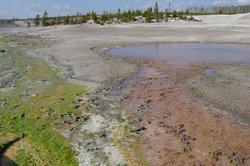Chloroflexus aurantiacus
|
|
Chloroflexus aurantiacus is a photosynthetic bacterium isolated from hot springs, belonging to the green non-sulfur bacteria. This organism is thermophilic and can grow at temperatures from 35° to 70°C. Chloroflexus aurantiacus can survive in the dark if oxygen is available. When grown in the dark, Chloroflexus aurantiacus has a dark orange color. When grown in sunlight it is dark green. The individual bacteria tend to form filamentous colonies.
| Contents |
Evolution of photosynthesis
One of the main reasons for interest in Chloroflexus aurantiacus is in the study of the evolution of photosynthesis. As terrestrial mammals, we are most familiar with photosynthetic plants such as trees. However, photosynthetic eukaryotes are a relatively recent evolutionary development. Photosynthesis by eukaryotic organisms can be traced back to endosymbiotic events in which non-photosynthetic eukaryotes internalized photosynthetic organisms. The chloroplasts of trees still retain their own DNA as a molecular remnant that indicated their origin as photosynthetic bacteria.
The "respiration early" hypothesis
How did photosynthesis arise in bacteria? The answer to this question is complicated by the fact that there are several types of light-harvesting energy capture systems. Chloroflexus aurantiacus has been of interest in the search for origins of the so-called type II photosynthetic reaction center. One idea is that bacteria with respiratory electron transport "invented" photosynthesis by coupling a light-harvesting energy capture system to the pre-existing respiratory electron transport chain. Thus, rare organisms like Chloroflexus aurantiacus that can survive using either respiration or photosynthesis are of interest in on-going attempts to trace the evolution of photosynthesis. Shown below is an example of a "respiration early" theory in which Chloroflexus aurantiacus is a living example of the kind of organism that may have first developed photosynthesis based on chlorophyll.
Related articles
References
- 1974 Article with report of the isolation of Chloroflexus aurantiacus. NCBI PubMed entry: "A phototrophic gliding filamentous bacterium of hot springs, Chloroflexus aurantiacus, gen. and sp. nov." (http://www.ncbi.nlm.nih.gov:80/entrez/query.fcgi?cmd=Retrieve&db=pubmed&dopt=Abstract&list_uids=4374148)
- PubMed Article: "Temperature dependence of growth and membrane-bound activities of Chloroflexus aurantiacus energy metabolism" (http://www.pubmedcentral.nih.gov/articlerender.fcgi?tool=pubmed&pubmedid=6863222)
- PubMed Article: "Isolation and development of chlorosomes in the green bacterium Chloroflexus aurantiacus" (http://www.pubmedcentral.nih.gov/articlerender.fcgi?tool=pubmed&pubmedid=7275928)
- NCBI PubMed Abstract: A cytochrome b origin of photosynthetic reaction centers: an evolutionary link between respiration and photosynthesis (http://www.ncbi.nlm.nih.gov:80/entrez/query.fcgi?cmd=Retrieve&db=pubmed&dopt=Abstract&list_uids=12367526)
- NCBI PubMed Abstract: Evolutionary relationships between "Q-type" photosynthetic reaction centres: hypothesis-testing using parsimony (http://www.ncbi.nlm.nih.gov:80/entrez/query.fcgi?cmd=Retrieve&db=pubmed&dopt=Abstract&list_uids=2246901)
- NCBI PubMed Abstract: Evolution of energetic metabolism: the respiration-early hypothesis (http://www.ncbi.nlm.nih.gov:80/entrez/query.fcgi?cmd=Retrieve&db=pubmed&dopt=Abstract&list_uids=8578586)


